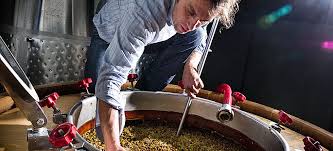
Burja Estate was established in 2009 by winemaker Primož Lavrencic in Vipava Valley, Slovenia, when he decided to buy a 60-year-old Malvasia vineyard. His mission is to continue to foster the tradition of Vipava viticulture and winegrowing and build a strong regional wine brand together with colleagues from Vipava. To enjoy this process in the sequence of many tiny good moments.
The Burja Estate connects a traditional Vipava winegrowing farm with modern understanding of wine. But aren’t the two actually the same? Don’t we want to recognize our roots, bases and flavors in wine and at the same time feel the soil and climate of the vineyards?

Principles
1. I believe in integrity, rather than individual actions that solve one problem and open three new ones. Therefore, I try to find answers to my constant questions. I listen to various opinions that come both from the scientific world and experienced farmers. I seek to balance physical sensations and actions with the spiritual dimension.
2. I respect local varieties. So I bought a 60-year-old Malvasia vineyard. Besides, the vines that I grow in my vineyards originate in Vipava Valley and along the northern Adriatic coast: Zelen, Pokalca (Schioppettino), Refošk (Refosco), Rebula (Ribolla Gialla), Malvazija (Malvasia d`Istria),
Laški rizling (Italian Riesling, Welschriesling), Modra frankinja (Blaufränkisch). I also inherited vineyards of Modri pinot (Pinot Noir, Blauburgunder), my passion and my tribute to the land of Burgundy.
3. I am becoming aware of the diversity and richness of our vineyards. I think that micro flora is an important part of each vineyard’s identity. The work in my vineyards, which are treated according to the principles of biological and biodynamic production, is in the spotlight. I am getting to know the details of soil and climate diversity for individual locations and I try to use this information to adjust different varieties and vineyard cultivation.
I try to step back and understand how to encourage nature, especially the soil, to express its own character in my wines.
4. I control only a few things and I allow all the others. I control the temperature and oxidation in the wine cellar, encouraging the rest. I try to work in synergy with the vine, wine and nature, including stimulating spontaneous fermentation, which ensures the contact between grape skin and must also with the white wines. According to my opinion, the diversity of yeast strains contributes to the complexity of the wine and provides original expression of each vineyard.




















































